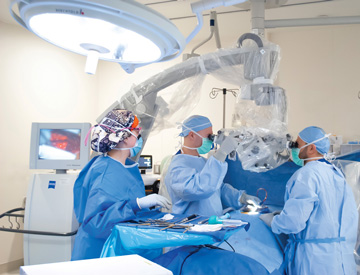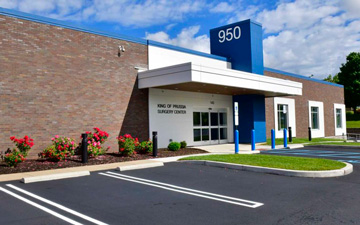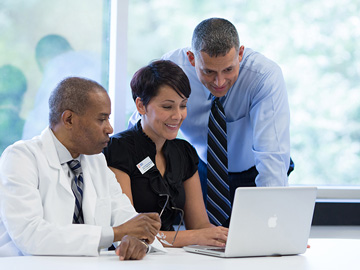The specialty offers incredible growth potential but planning and execution must be thorough to ensure safety and profitability.
 The Surgery Center at Shrewsbury
The Surgery Center at Shrewsbury
INTRODUCING SPINE Each of the nine 520-square-foot, specialty-agnostic ORs inside the Surgery Center at Shrewsbury are well equipped to accommodate spine surgeries.
The provision of high-quality, accessible outpatient spine procedures requires careful planning, specialized equipment and instrumentation, a safety-first focus and a keen awareness of local healthcare needs.
Take, for instance, the 35,000-square-foot, multispecialty Surgery Center at Shrewsbury (Mass.), a collaboration among Shields Health Care, Reliant Medical Group and UMass Memorial Health that opened in 2018. In October 2021, the first outpatient spine procedure was performed there, a discectomy at the L3-L4 region, with a plan to gradually increase volume and procedural mix over the coming months and years.
When the facility opened, it performed numerous orthopedic and sports medicine surgeries and some plastic surgery procedures. "From day one, we focused on how to grow those service lines while also assessing the potential for growth into other specialties and services in the future, especially spine," says Prashanth Bala, MS, MHA, chief of ambulatory surgical services at Shields Health Care. "Building a spine service line demands careful and thoughtful planning, understanding local market conditions, and having substantive discussions with surgeons, anesthesia providers and staff that result in collective agreement on what procedures, equipment and protocols your center will offer, utilize and implement."
Mr. Bala points to several factors that have led to the successful, sustainable initiation of a spine line.
Physical space. At 520 square feet, each of the facility's nine ORs were built to be specialty-agnostic. Thirty total joints cases per month are performed in them, for example. "Adding spine, which to us represents the most exciting frontier for the musculoskeletal work we do, was always the logical next step after total joints," says Mr. Bala, who notes the specialty required no specific modifications to the facility's waiting rooms and pre-op or recovery spaces, and that shelf space was reserved for spine equipment three years before the line was added. "If you're designing a new facility, look forward five, 10 or 15 years into the future," he says. "Always design for growth if you plan to expand upon your service lines, especially if, like spine, they will require significant space."
Capital equipment. Get your spine surgeons on the same page and standardize as much equipment as possible to avoid overinvestment based on any one surgeon's preferences, says Mr. Bala. "We were able to control costs by focusing first on purchasing equipment and supplies for specific procedures all our surgeons would use, and then strategically adding to our fleet of attachments as needed," he says. "Start slow and grow from there once you have a foundational inventory."
The two most important spine-specific types of equipment are positioning frames for different procedures and a surgical microscope, says Mr. Bala. "Specialty patient positioning devices are expensive and take up valuable space," he says. "To save both money and square footage, only buy the frames you absolutely need." Microscopes are important to some but not all spine surgeons, he adds. "Some surgeons prefer to use them because they can stand up and see vascular conditions in and around the different components of the spine without needing to hover over the surgical field," he says.
Implants and trays. Spine procedures typically involve five to seven trays, says Mr. Bala. "A key for us was narrowing down exactly how much instrumentation our surgeons would need for a given case," he says. "We've engaged our vendors to focus our supply purchasing process and, as a result, we've reduced it down to three to five trays. We call them our ‘spine sets,' and all our surgeons have agreed on what they should include. We've avoided overloading sterile processing while also saving storage space."
Staff. You won't necessarily need specialized staff, but same-day spine surgeries require careful attention to preoperative preparation and postoperative recovery. "The surgery might be the same as what's done in a hospital, but the recovery phase is different because patients aren't wheeled to the floor postoperatively where someone can monitor them overnight," says Mr. Bala. "Instead, you need to prepare your patients to go home the day of surgery and recover appropriately." A staff nurse designated as the facility's full-time "complex care coordinator" works with surgeons to ensure expectations are set with patients, secure the patient's information from the surgeon's office and consult with the surgeon on areas of concern about the patient.
Payments. With commercial payers growing more bullish on outpatient spine in safe, proven environments, potential patient volume is growing. "We have a responsibility to ensure patients know that it is no longer required to get this type of care at a hospital, and that they'll receive the highest quality of care at our outpatient facility," says Mr. Bala. "To attract top physicians, we have tailored an efficient, safe, standardized program that will make them feel comfortable and confident working here, and ensure every patient receives the same high quality of care," he says.
"Everything we've done with our spine line has been a ‘crawl before we walk, walk before we run' approach," says Mr. Bala. "Our growth in spine is designed to be thoughtful and purposeful, so that when we expand, we're not just growing for the sake of growth."
 King of Prussia Surgery Center
King of Prussia Surgery Center .svg?sfvrsn=be606e78_3)



.svg?sfvrsn=56b2f850_5)